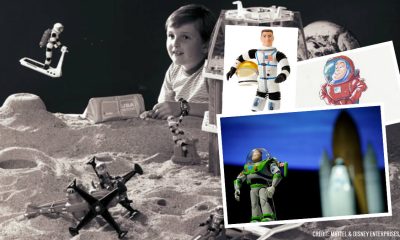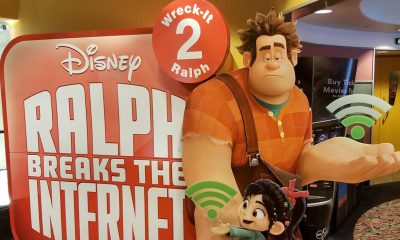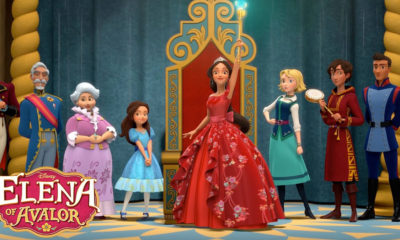This month is the 59th anniversary of the premiere of Disney’s still controversial “Song of the South.” Even though Disney has released the film in both Asian and European markets with no race riots occurring nor lengthy diatribes published condemning the film, the Walt Disney Company still hesitates to release the film in the United States. Despite the fact that — for many years now — there has been a healthy “blackmarket” selling bootleg copies to those who desperately want to see the film.
However, the story of why “Song of the South” is not available in the United States and the controversy sparked by its initial release is a saddening mixture of insensitivity, misunderstandings, and urban legends. It is a much more tangled web than many people realize.
Thanks to the extensive research work of Animation Historian Karl Cohen, whose book “Forbidden Animation” from McFarland Press devotes an entire chapter to the film’s release, and the historical article on the making of the film by Disney Historian Jim Korkis entitled “Who’s Afraid of the Song of the South?” that is scheduled to be printed early next year, I think I have enough understanding now to briefly discuss the connection of the NAACP in the controversy surrounding the film. I’d like to thank both those gentlemen for their groundbreaking research work.
It is important to remember that the “Song of the South” came out in 1946 and there was no balance of media images that featured the Huxtable family or John Shaft or George Jefferson or even Spike Lee. African-American performers often portrayed comic roles where they were characterized as lazy, slow-witted, easily scared, subserviant and worse.
Also remember that in 1946, the United States was a highly segregated country with separate facilities for non-whites. And that the brutal torture and lynching of African-Americans was so commonplace that the National Headquarters of the NAACP would fly a black flag out its window when news of a new lynching was confirmed.
The National Association for the Advancement of Colored People (NAACP) was officially formed on February 12, 1909 (timed to coincide with Abraham Lincoln’s one-hundredth birthday, although the name itself was not chosen until 1910). Appalled at the violence that was committed against African-American citizens including wide-spread lynchings as well as the “Jim Crow” laws that promoted racial discrimination and segregation, the organization contained both white and black members. In fact, white members held key positions on the board in the beginning.
One of its first protests against the portrayal of African-Americans in films was during the release of D.W. Griffith’s “Birth of a Nation” (1915) that the NAACP felt glamorized the birth of the Ku Klux Klan and sparked race riots across the country. Despite all its nationwide attempts to have the film banned, “Birth of the Nation” became a highly successful film and it is still widely available today as an example of innovations in filmmaking even while its racial slant is criticized.
Throughout the 1940s the NAACP saw enormous growth in its membership, claiming nearly 500,000 members by 1946. However, it wasn’t until 1948, that the NAACP was successful in pressuring President Harry Truman to sign an Executive Order banning discrimination by the Federal government.
When “Song of the South” was released, the NAACP was acting as a legislative and legal advocate, pushing unsuccessfully for a federal anti-lynching law and for an end to state-mandated segregation.
The NAACP attempted to create a “Hollywood Bureau” to convince Hollywood Studios to counter derogatory stereotypes of African Americans in motion pictures and to promote more realistic roles for black performers. There was extensive correspondence with producers such as David O. Selznick, Daryl F. Zanuck and other major studio moguls about such classic films as “Gone With the Wind,” “Ox Bow Incident,” “Pinky” and — of course — “Song of the South”.
The Disney Studio had come under close scrutiny when it first announced its work on the stories of Uncle Remus.
Reading the first drafts for the screenplay prepared by a Southern author named Dalton Reymond, who
sprinkled the script with stereotypes and terms that were offensive when referring to African Americans, The Hays Office sent a warning to Disney. It was non-negotiable that those terms needed to be removed but that overall the film was acceptable in meeting the demands of the Production Code. However it strongly suggested “… again the advisability of your taking counsel with some responsible Negro authorities concerning the overall acceptability, from the standpoint of Negroes, of this story … Our Negro friends appear to be a bit critical of all motion picture stories which treat their people, and it may be that they will find in this story some material which may not be acceptable to them.”
Disney hired Clarence Muse in 1944. Clarence Edouard Muse was born in 1889. He was an African-American lawyer, writer, director, composer, and actor. After high school he earned a degree in International Law from The Dickinson School of Law of Pennsylvania in 1911. Disgusted with the poor opportunities for Black lawyers he then selected a show business career. Muse appeared as an opera singer, minstrel show performer, vaudeville and Broadway actor; he also wrote songs, plays, and sketches. He appeared in very dignified roles in films made for all Black audiences and was so articulate as to be considered a spokesman for the Black community.
Muse quit Disney early in 1944 after his ideas to portray the African American characters as more dignified and prosperous were rejected. Once Muse left Disney, he began to inform people about the nature of the Disney feature while it was still in the rough draft outline and before radical leftist screenwriter, Maurice Rapf had been brought in to make the script more acceptable. Muse wrote letters to the editors of black publications a that Disney was going to depict Negroes in an inferior capacity and that the film was “detrimental to the cultural advancement of the Negro people.” So the pump was already primed for disaster.
In later years, screenwriter Maurice Rapf remembered that Walt “had a theory that the reason why the film was picketed and particularly attacked by the Los Angeles chapter of the NAACP was because the head of the local chapter was actor Clarence Muse. He knew that Walt Disney wanted to do a Remus story, and Muse wanted to play Remus. He was a standard serious black actor, but Disney got someone else. Now others said that couldn’t be true, because Muse was a technical adviser on the film, though I think if that’s true he didn’t do a very good job advising.”
Both Walter White, the executive secretary of the NAACP at the time, and June Blythe, the director of the American Council on Race Relations, had requested to see a treatment of Disney’s “Song of the South” when the production was first announced. But they were ignored or politely given the run-around. Neither the NAACP nor the American Council on Race Relations had any opportunity to review the project before the press screening.
“Song of the South” had its premiere at Atlanta’s Fox Theater on November 12, 1946. The location was chosen to tie in with author Joel Chandler Harris who besides writing several books of the Uncle Remus stories was also a popular writer on the “Atlanta Constitution.”
However, “Song of the South’s” African American cast members were not able to join Walt Disney and the white cast members at the movie’s premiere in Atlanta, GA. because Atlanta was a segregated city. African Americans could not enter the movie theater or any other public buildings downtown. No hotel within reach of the theater would rent a room to James Baskett who portrayed Uncle Remus.
Walter White, the executive secretary of the NAACP, telegraphed major newspapers around the country with the following statement:
“The National Association for the Advancement of Colored People recognizes in ‘Song of the South’ remarkable artistic merit in the music and in the combination of living actors and the cartoon technique. It regrets, however, that in an effort neither to offend audiences in the north or south, the production helps to perpetuate a dangerously glorified picture of slavery. Making use of the beautiful Uncle Remus folklore, ‘Song of the South’ unfortunately gives the impression of an idyllic master-slave relationship which is a distortion of the facts.”
However, White had not yet seen the film and based his statement on memos sent to him by two NAACP staff members in New York who had attended a press screening on November 20, 1946. Norma Jensen wrote that the film was “so artistically beautiful that it is difficult to be provoked over the clichés” but that the film did contain “all the clichés in the book.” She did feel the Uncle Remus stories were commendable and she found “very touching” the relationship between the rich white boy and the black boy and white daughter of a tenant farmer but objected to scenes like the African Americans singing traditional songs since it was an offensive stereotype.
The other staff member, Hope Springarn, listed several objectionable images in the film, including the use of Negro dialect and the “Negroes singing outside the house” when the little white boy was dying.
Both Jensen and Springarn were also confused about the time of the story since it wasn’t clear that it was taking place during the Reconstruction and not during the Plantation days of slavery. It was something that also confused other reviewers who from the tone of the film and the type of similar recent Hollywood movies assumed it must also be set during the time of slavery.
So based on the information in those memos, White released the official position of the NAACP in that telegram that was widely quoted in newspapers including the December 4, 1946 issue of “Variety”, the trade journal of the motion picture industry.
Racially diverse groups of protesters organized to picket movie theaters in major American cities such as New York City, Los Angeles, San Francisco, and Boston. Yet the racial “harmony” demonstrated by these integrated groups of protesters was not common in most of the United States at the time and the philosophical make-up of these protestors resembled similar groups that protested and marched for civil rights in the Sixties. They were not so much protesting a particular incident or item but using that particular thing as a forum to protest a much larger injustice.
“We want films on Democracy not Slavery” and “Don’t prejudice children’s minds with films like this” were some of the slogans that decorated the signs of a racially diverse group of protesters who marched outside of the Paramount Theater in downtown Oakland, California. The protesters included African Americans and whites, men and women, old and young. The location of the protest was significant because in the 1940s, downtown Oakland was an elegant district with fancy hotels, expensive department stores, and several large-scale movie “palaces.”
At the film’s New York premiere in Times Square, dozens of black and white picketers, including African American servicemen recently returned from fighting in World War II, chanted:”We fought for Uncle Sam, not Uncle Tom.” While local chapters of the NAACP called for a total boycott of the film. And The National Negro Congress declared that the film “is an insult to the Negro people because it uses offensive dialect; it portrays the Negro as a low, inferior servant; it glorifies slavery” and called on Black people to “run the picture out of the area.”
The New York Tribune reported that at a press conference Walt Disney said that any real antagonism towards the film would come from radicals “who just love stirring up trouble whenever they can.” Disney defended it as a “monument to the Negro race,” pointing out that it was set after the Civil War and therefore could not be about slavery and “that the time had not yet come when Negro susceptibilities could be treated with as much delicacy as Hollywood reserves for, say, American Catholics.”
New York Times film reviewer Bosley Crowther wrote that the movie was a “travesty on the antebellum South…no matter how much one argues that it’s all childish fiction, anyhow, the master-and-slave relation is so lovingly regarded in your yarn, with the Negroes bowing and scraping and singing spirituals in the night that one might almost imagine that you figure Abe Lincoln made a mistake. Put down that mint julep, Mr. Disney.”
So did the NAACP kill Disney’s “Song of the South”? Not really, even though its initial criticism of the film may have been based on some faulty information. It did use the film as a rallying point that resulted in some changes in how films depicting African Americans were made.
Walt and the Disney Studio were not totally innocent either. The ambiguity of the story suggesting that all those happy, singing African Americans might indeed by slaves and Walt naively treating the film as another Disney fantasy (evident by those strong Mary Blair color stylings even in the live action scenes) rather than realizing that using real people would make people think it was all real added to the confusion and made defending the film more difficult than it should have been.
In a public interview, actor James Baskett who played Uncle Remus responded to the criticism by saying: “I believe that certain groups are doing my race more harm in seeking to create dissension than can ever possibly come out of the ‘Song of the South’.”

Film & Movies
How Disney’s “Bambi” led to the creation of Smokey Bear

When people talk about Disney’s “Bambi,” the scene that they typically cite as being the one from this 1942 film which then scarred them for life is – of course – the moment in this movie where Bambi’s mother gets shot by hunters.
Which is kind of ironic. Given that – if you watch this animated feature today – you’ll see that a lot of this ruined-my-childhood scene actually happens off-camera. I mean, you hear the rifle shot that takes down Bambi’s Mom. But you don’t actually see that Mama Deer get clipped.
Now for the scariest part of that movie that you actually see on-camera … Hands down, that has to be the forest fire sequence in “Bambi.” As the grown-up Bambi & his bride, Faline, desperately race through those woods, trying to find a path to safety as literally everything around them is ablaze … That sequence is literally nightmare fuel.
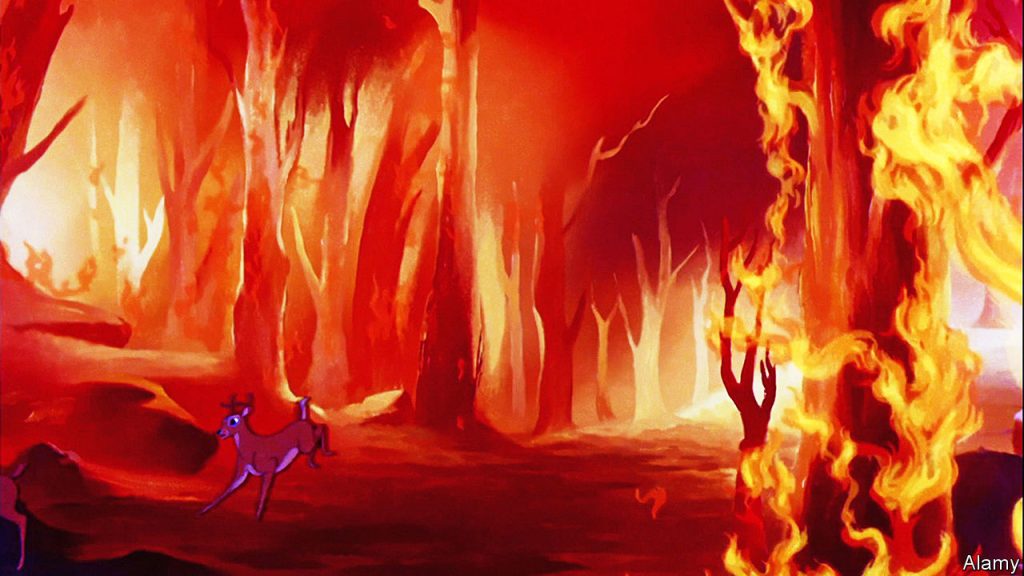
Mind you, the artists at Walt Disney Animation Studios had lots of inspiration for the forest fire sequence in “Bambi.” You see, in a typical year, the United States experiences – due to either natural phenomenon like lightning strikes or human carelessness – 100 forest fires. Whereas in 1940 (i.e., the year that Disney Studios began working in earnest of a movie version of Felix Salten’s best-selling movie), America found itself battling a record 360 forest fires.
Which greatly concerned the U.S. Forest Service. But not for the reason you might think.
Protecting the Forest for World War II
I mean, yes. Sure. Officials over in the Agricultural Department (That’s the arm of the U.S. government that manages the Forest Service) were obviously concerned about the impact that this record number of forest fires in 1940 had had on citizens. Not to mention all of the wildlife habitat that was now lost.
But to be honest, what really concerned government officials was those hundreds of thousands of acres of raw timber that had been consumed by these blazes. You see, by 1940, the world was on the cusp of the next world war. A conflict that the U.S. would inevitably be pulled into. And all that now-lost timber? It could have been used to fuel the U.S. war machine.
So with this in mind (and U.S. government officials now seeing an urgent need to preserve & protect this precious resource) … Which is why – in 1942 (just a few months after the Japanese bombed Pearl Harbor) – the U.S. Forest Service rolls out its first-ever forest fire prevention program.
Which – given that this was the early days of World War II – the slogan that the U.S. Forest Service initially chose for its forest fire prevention program is very in that era’s we’re-all-in-this-together / so-let’s-do-what-we-can-to-help-America’s war-effort esthetic – made a direct appeal to all those folks who were taking part in scrap metal drives: “Forest Defense is National Defense.”

And the poster that the U.S. Forest Service had created to support this campaign? … Well, it was well-meaning as well. It was done in the WPA style and showed men out in the forest, wielding shovels to ditch a ditch. They were trying to construct a fire break, which would then supposedly slow the forest fire that was directly behind them.
But the downside was … That “Forest Defense is National Defense” slogan – along with that poster which the U.S. Forest Service had created to support their new forest fire prevention program didn’t exactly capture America’s attention.
I mean, it was the War Years after all. A lot was going in the country at that time. But long story short: the U.S. Forest Service’s first attempt at launching a successful forest fire prevention program sank without a trace.
So what do you do in a situation like this? You regroup. You try something different.
Disney & Bambi to the Rescue
And within the U.S. government, the thinking now was “Well, what if we got a celebrity to serve as the spokesman for our new forest fire prevention program? Maybe that would then grab the public’s attention.”
The only problem was … Well, again, these are the War Years. And a lot of that era’s A-listers (people like Jimmy Stewart, Clark Gable, even Mel Brooks) had already enlisted. So there weren’t really a lot of big-name celebrities to choose from.
But then some enterprising official at the U.S. Forest Service came up with an interesting idea. He supposedly said “Hey, have you seen that new Disney movie? You know, the one with the deer? That movie has a forest fire in it. Maybe we should go talk with Walt Disney? Maybe he has some ideas about how we can better capture the public’s attention when it comes to our new forest fire prevention program?”
And it turns Walt did have an idea. Which was to use this government initiative as a way to cross-promote Disney Studio’s latest full-length animated feature, “Bambi.” Which been first released to theaters in August of 1942.
So Walt had artists at Disney Studio work up a poster that featured the grown-up versions of Bambi the Deer, Thumper the Rabbit & Flower the Skunk. As this trio stood in some tall grasses, they looked imploring out at whoever was standing in front of this poster. Above them was a piece of text that read “Please Mister, Don’t Be Careless.” And below these three cartoon characters was an additional line that read “Prevent Forest Fires. Greater Danger Than Ever!”
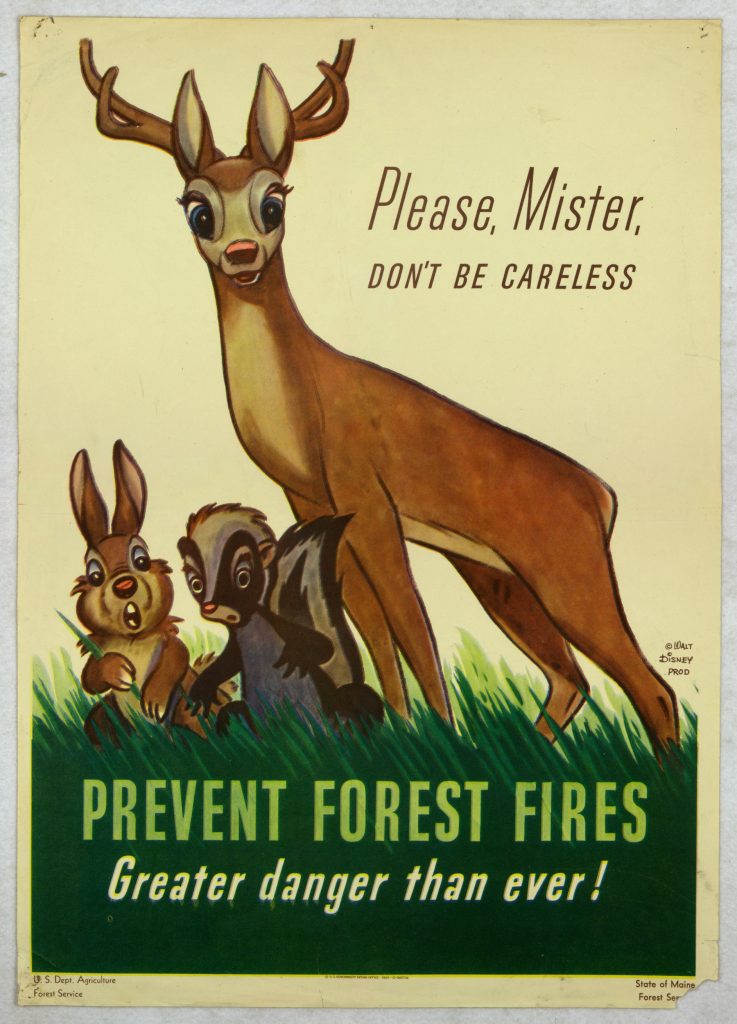
According to folks I’ve spoken with at Disney’s Corporate Archives, this “Bambi” -based promotional campaign for the U.S. Forest Service’s forest fire prevention campaign was a huge success. So much so that – as 1943 drew to a close – this division of the Department of Agriculture reportedly reached out to Walt to see if he’d be willing to let the U.S. Forest Service continue to use these cartoon characters to help raise the public’s awareness of fire safety.
Walt – for reasons known only to Mr. Disney – declined. Some have suggested that — because “Bambi” had actually lost money during its initial theatrical release in North America – that Walt was now looking to put that project behind him. And if there were posters plastered all over the place that then used the “Bambi” characters that then promoted the U.S.’s forest fire prevention efforts … Well, it would then be far harder for Mr. Disney to put this particular animated feature in the rear view mirror.
Introducing Smokey Bear
Long story short: Walt said “No” when it came to reusing the “Bambi” characters to promote the U.S. Forest Service’s forest fire prevention program. But given how successful the previous cartoon-based promotional campaign had been … Well, some enterprising employee at the Department of Agriculture reportedly said “Why don’t we come up with a cartoon character of our own?”
So – for the Summer of 1944 – the U.S. Forest Service (with the help of the Ad Council and the National Association of State Foresters) came up with a character to help promote the prevention of forest fires. And his name is Smokey Bear.
Now a lot of thought had gone into Smokey’s creation. Right from the get-go, it was decided that he would be an American black bear (NOT a brown bear or a grizzly). To make this character seem approachable, Smokey was outfitted with a ranger’s hat. He also wore a pair of blue jeans & carried a bucket.
As for his debut poster, Smokey was depicted as pouring water over a still-smoldering campfire. And below this cartoon character was printed Smokey’s initial catchphrase. Which was “Care will prevent 9 out of 10 forest fires!”
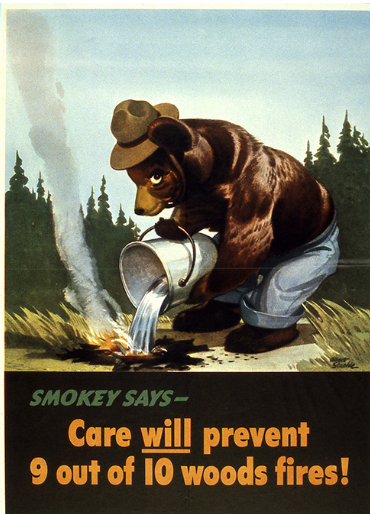
Which makes me think that this slogan was written by the very advertising executive who wrote “Four out of five dentists recommend sugarless gum for their patients who chew gum.”
Anyway … By the Summer of 1947, Smokey got a brand-new slogan. The one that he uses even today. Which is “Only YOU can prevent forest fires.”
The Real Smokey Bear
Now where this gets interesting is – in the Summer of 1950 – there was a terrible forest fire up in the Capitan Mountains of New Mexico. And over the course of this blaze, a bear cub climbed high up into a tree to try & escape those flames.
Firefighters were finally able to rescue that cub. But he was so badly injured in that fire that he was shipped off to the National Zoo in Washington, D.C. and nursed back to health. And since this bear really couldn’t be released back in the wild at this point, he was then put on exhibit.
And what does this bear’s keepers decide to call him? You guessed it: Smokey.
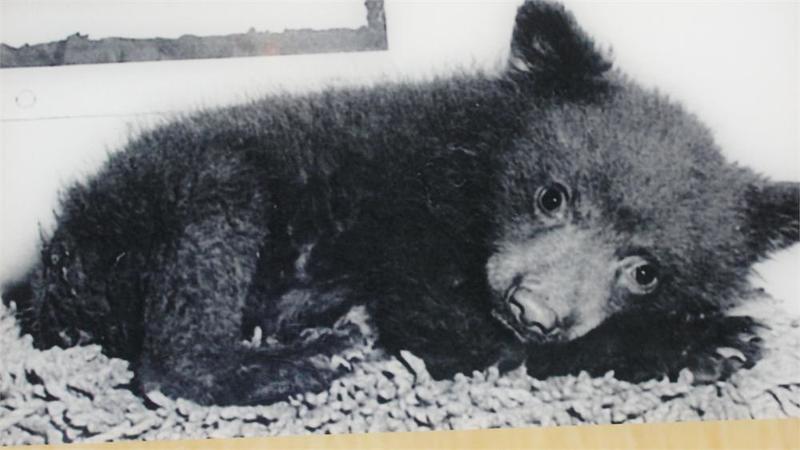
And due to all the news coverage that this orphaned bear got, he eventually became the living symbol of the U.S. Forest Service’s forest fire prevention program. Which then meant that this particular Smokey Bear got hit with a ton of fan mail. So much so that the National Zoo in Washington D.C. wound up with its own Zip Code.
“Smokey the Bear” Hit Song
And on the heels of a really-for-real Smokey Bear taking up residence in our nation’s capital, Steve Nelson & Jack Rollins decide to write a song that shined a spotlight on this fire-fightin’ bruin. Here’s the opening stanza:
With a ranger’s hat and shovel and a pair of dungarees,
You will find him in the forest always sniffin’ at the breeze,
People stop and pay attention when he tells them to beware
Because everybody knows that he’s the fire-preventin’ bear
Believe or not, even with lyrics like these, “Smokey the Bear” briefly topped the Country charts in the Summer of 1950. Thanks to a version of this song that was recorded by Gene Autry, the Singing Cowboy.
By the way, it was this song that started all of the confusion in regards to Smokey Bear’s now. You see, Nelson & Rollins – because they need the lyrics of their song to scan properly – opted to call this fire-fightin’-bruin Smokey THE Bear. Rather than Smokey Bear. Which has been this cartoon character’s official name since the U.S. Forest Service first introduced him back in 1944.
“The Ballad of Smokey the Bear”
Further complicating this issue was “The Ballad of Smokey the Bear,” which was a stop-motion animated special that debuted on NBC in late November of 1966. Produced by Rankin-Bass as a follow-up to their hugely popular “Rudolph the Red-Nosed Reindeer” (which premiered on the Peacock Network in December of 1964) … This hour-long TV show also put a “THE” in the middle of Smokey Bear’s name because the folks at Rankin-Bass thought his name sounded better that way.
And speaking of animation … Disney’s “Bambi” made a brief return to the promotional campaign for the U.S. Forest Service’s forest fire prevention program in the late 1980s. This was because the Company’s home entertainment division had decided to release this full-length animated feature on VHS.
What’s kind of interesting, though, is the language used on the “Bambi” poster is a wee different than the language that’s used on Smokey’s poster. It reads “Protect Our Forest Friends. Only You Can Prevent Wildfires.” NOT “Forest Fires.”
Anyway, that’s how Disney’s “Bambi” led to the creation of Smokey Bear. Thanks for bearin’ with me as I clawed my way through this grizzly tale.
Film & Movies
“Indiana Jones and the Search for Indiana Jones”
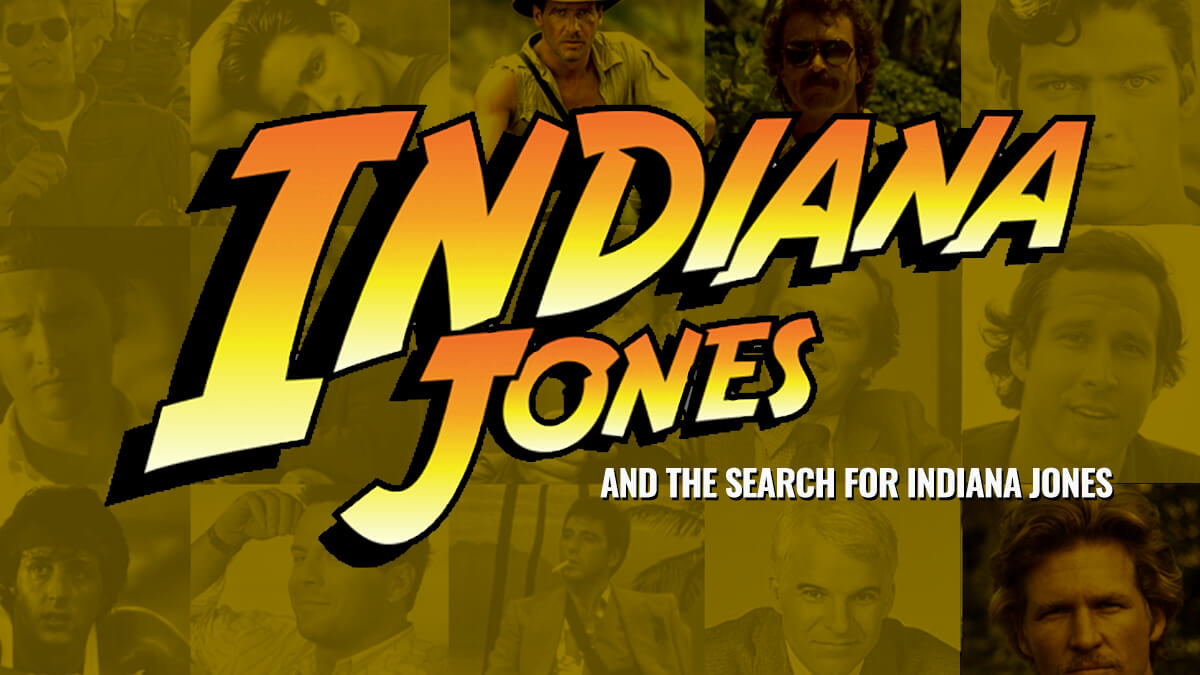
News came late last week that NBC was cancelling the “Magnum PI” remake. This series (which obviously took its inspiration from the Tom Selleck show that originally debuted on CBS back in December of 1980 and then went on run on that network for 8 seasons . With its final episode airing on May 8, 1988 ).
Anyway … Over 30 years later , CBS decided to remake “Magnum.” This version of the action drama debuted on September 24, 2018 and ran for four seasons before then being cancelled. NBC picked up the “Magnum” remake where it ran for one more season before word came down on June 23 rd that this action drama was being cancelled yet again.
FYI: The second half of Season 5 of “Magnum” ( 10 episodes ) has yet to air on NBC. It will be interesting to see when that final set of shows / the series finale gets scheduled.
This all comes to mind this week – out ahead of the theatrical release of “Indiana Jones and the Dial of Destiny” because … Well, if CBS execs had been a bit more flexible back in 1980 , the star of the original version of “Magnum PI” (Tom Selleck) would have played the lead in “Raiders of the Lost Ark.” Which was released to theaters back on June 12, 1981 .
That’s the part of the Indiana Jones story that the folks at Lucasfilm often opt to skim over.
That Harrison Ford wasn’t George Lucas’ first choice to play Doctor Jones.
Auditions for Indiana Jones – Harrison’s Not on the List
Mind you, Steven Spielberg – right from the get-go – had pushed for Ford to play this part. The way I hear it, Lucas showed Spielberg a work-in-progress cut of “The Empire Strikes Back.” And Steven was so taken with Harrison’s performance as Han Solo in that Irwin Kershner film that he immediately began pushing for Ford to be cast as Doctor Jones.
Whereas Mr. Lucas … I mean, it wasn’t that George had anything against Harrison. What with Ford’s performances first in “American Grafitti” and then in “A New Hope,” these two already had a comfortable working relationship.
But that said, Lucas was genuinely leery of … Well, the sort of creative collaboration that Martin Scorcese and Robert DeNiro. Where one actor & one director repeatedly worked together. To George’s way of thinking, that was a risky path to follow. Hitching your wagon to a single star.
Which is why – when auditions got underway for “Raiders of the Lost Ark” in 1979 — Mike Fenton basically brought in every big performer of that era to read for Dr. Jones except Harrison Ford. We’re talking:
- Steve Martin
- Chevy Chase
- Bill Murray
- Jack Nicholson
- Peter Coyote
- Nick Nolte
- Sam Elliot
- Tim Matheson
- and Harry Hamlin
Casting a Comedian for Indiana Jones
Please note that there are a lot of comedians on this list. That’s because – while “Raiders of the Lost Ark” was in development — Spielberg was directed his epic WWII comedy, “1941.” And for a while there, Steve & George were genuinely uncertain about whether the movie that they were about to make would be a sincere valentine to the movie serials of the 1930s & the 1940s or more of a spoof.
It’s worth noting here that three of the more ridiculous set pieces found in “Temple of Doom” …
- the shoot-out at Club Obi Wan in Shanghai
- Indy, Willie & Short Round surviving that plane crash by throwing an inflatable life raft out of the cargo hatch
- and that film’s mine cart chase (which was not only inspired by Disney theme park favorites the Matterhorn Bobsleds & Big Thunder Mountain Railroad but some of the sound effects that you hear in this portion of “Temple of Doom” were actually recorded after hours at Disneyland inside of these very same attractions)
… all originally supposed to be in “Raiders of the Lost Ark.” I’ve actually got a copy of the very first version of the screenplay that Lawrence Kasdan wrote for the first “Indy” movie where all three of these big action set pieces were supposed to be part of the story that “Raiders” told. And I have to tell you that this early iteration of the “Raiders” screenplay really does read more like a spoof of serials than a sincere, loving salute to this specific style of cinema.
Casting Indiana Jones – Jeff or Tom
Anyway … Back now to the casting of the male lead for “Raiders” … After seeing virtually every actor out in LA while looking for just the right performer to portray Indiana Jones, it all came down to two guys:
- Jeff Bridges
- and Tom Selleck
Jeff Bridges as Indiana Jones
Mike Fenton was heavily pushing for Jeff Bridges. Having already appeared with Clint Eastwood in 1974 ’s “Thunderbolt & Lightfoot” (Not to mention that “King Kong” remake from 1976 ), Bridges was a known quantity. But what Fenton liked especially liked about Bridges when it came to “Raiders” was … Well, at that time, Jeff was just coming off “Heaven’s Gate.”
Mind you, nowadays, because we’ve all now had the luxury of seeing the director’s cut of this Michael Cimino movie, we recognize “Heaven’s Gate” for the cinematic masterpiece that it is. But 40+ years ago , that honestly wasn’t the case. All audiences had to judge this movie by was the severely truncated version that United Artists sent out into theaters. Which – because “Heaven’s Gate” had cost $44 million to make and only sold $3.5 millionof tickets – then became the textbook example of Hollywood excess.
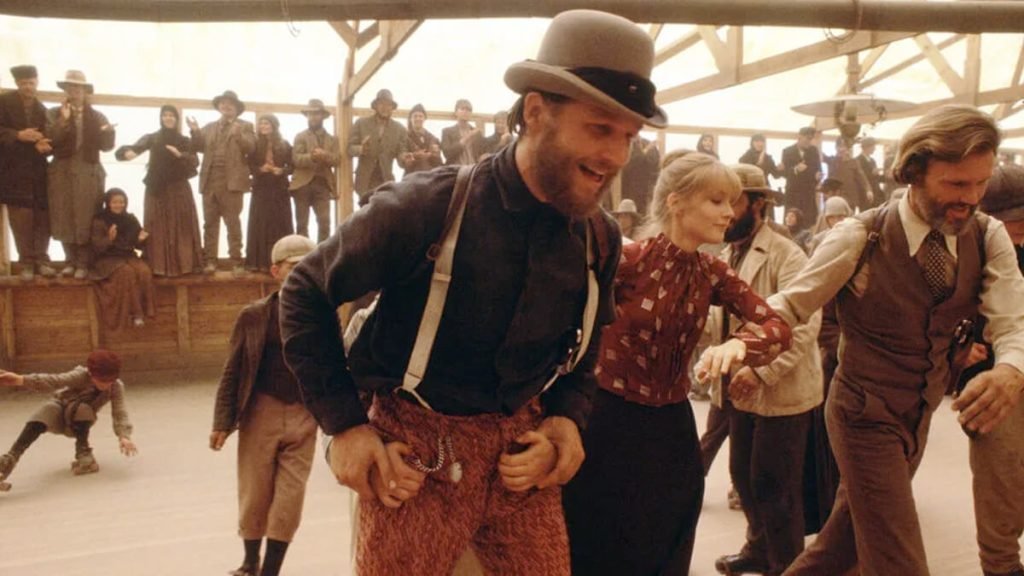
Long story short: Given that being associated with “Heaven’s Gate” had somewhat dinged Bridges’ reputation for being a marketable star (i.e., a performer that people would pay good money to see up on the big screen), Jeff was now looking to appear in something highly commercial. And the idea of playing the lead in a film directed by Steven Spielberg (the “Jaws” & “Close Encounter” guy) and produced by George Lucas (Mr. “Star Wars”) was very, very appealing at that time. Bridges was even willing to sign a contract with Spielberg & Lucas that would have then roped him into not only playing Indiana Jones in “Raider of the Lost Ark” but also to appear as this very same character in two yet-to-be-written sequels.
Better yet, because “Heaven’s Gate” had temporarily dimmed Bridges’ star status, Jeff was also willing to sign on to do the first “Indy” film for well below his usual quote. With the understanding that – should “Raiders of the Lost Ark” succeed at the box office – Bridges would then be paid far more to appear in this film’s two sequels.
That seemed like a very solid plan for “Raiders.” Landing a known movie star to play the lead in this action-adventure at a bargain price.
Ah, but standing in Mike Fenton’s way was Marcia Lucas.
Tom Selleck as Indiana Jones
Marcia Lucas, who had seen Tom Selleck’s audition for “Raiders” (And you can see it as well. Just go to Google and type in “Tom Selleck” and “Indiana Jones.” And if you dig around for a bit, you’ll then see a feature that Lucas & Spielberg shot for “Entertainment Tonight” back in 2008 [This story was done in support of the theatrical release of “Indiana Jones and the Kingdom of the Crystal Skull”]. And as part of this piece, George and Steve share Tom’s original audition for “Raiders.” And what’s genuinely fascinating about this footage is that Selleck’s scene partner is Sean Young. Who – at that time, anyway – was up for the role of Marion Ravenwood) and kept telling her husband, “You should cast this guy. He’s going to be a big star someday.”
And given that George was smart enough to regularly heed Marcia Lucas’ advice (She had made invaluable suggestions when it came to the editing of “American Graffiti” and the original “Star Wars.” Not to downplay George Lucas’ cinematic legacy, but Marcia Lucas was a world-class storyteller in and of her own right), Lucas then reached out to Spielberg and persuaded him that they should cast relative unknown Tom Selleck as Doctor Jones over the already well-known Jeff Bridges.
Now don’t feel too bad for Jeff Bridges. When he lost out on playing the lead in “Raiders of the Lost Ark,” Jeff then accepted a role in the very next, high profile, sure-to-be-commercial project that came along. Which turned out to be Disney’s very first “TRON” movie. Which was eventually released to theaters on July 9, 1982 .
Back to Tom Selleck now … You have to remember that – back then – Selleck was the handsome guy who’d already shot pilots for six different shows that then hadn’t gone to series. Which was why Tom was stuck being the guest star on shows like “The Fall Guy” and “Taxi.” Whereas once word got out around town that Selleck was supposed to play the lead in a project that Spielberg was directed & Lucas was producing … Well, this is when CBS decided that they’d now take the most recent pilot that Tom had shot and then go to series with this show.
That program was – of course – the original “Magnum PI.” And it’s at this point where our story started to get complicated.
“Magnum PI” – Two Out of Three Say “Yes”
Okay. During the first season of a TV show, it’s traditionally the network – rather than the production company (which – in this case – was Glen A. Larson Productions. The company behind the original versions of “Battlestar Galactica” & “Knight Rider”) or the studio where this series is actually being shot (which – in this case – was Universal Television) that has all the power. And in this particular case, the network execs who were pulling all the strings behind-the-scenes worked for CBS.
And when it came to the first season of “Magnum PI,” CBS had a deal with Glen A. Larson Productions and Universal Television which stated that the talent which had been contracted to appear in this new action drama would then be available for the production of at least 13 episodes with an option to shoot an additional 9 episodes (This is known in the industry as the back nine . As in: the last nine holes of a golf course).
Anyway, if you take those initial 13 episodes and then tack on the back nine , you then get 22 episodes total. Which – back in the late 1970s / early 1980s , anyway – was what a full season of a network television show typically consisted of.
Anyway … The contract that Selleck had signed with Glen A. Larson Productions, Universal Television & CBS stated that he had to be available when production of Season One of “Magnum PI” began in March of 1980. More to the point, Tom also had to be available should CBS exercise its option to air 22 episodes of this new series on that television network over the course of “Magnum PI” ‘s first season.
Which then made things complicated for George Lucas & Steven Spielberg because … Well, in order for “Raiders of the Lost Ark” to make its June 12, 1981 release date, that then meant that production of the first “Indy” movie would have to get underway no later than June 23, 1980 .
But here’s the thing: Production of Season One of “Magnum PI” was scheduled to run through the first week of July of that same year ( 1980 ). So in order for Tom Selleck to play Indiana Jones in “Raiders,” he was going to need to be wrapped on production of “Magnum PI” by June 22, 1980 at the absolute latest.
So Spielberg & Lucas went to Glen A. Larsons Productions and asked if Selleck could please be sprung from his “Magnum PI” contractual obligations by June 22 nd . And they said “Yes.” Then Steven & George went to Universal Television and asked executives there for their help in clearing Tom’s schedule so that he’d then be available to start work on “Raiders.” And they say “Yes” as well.
Spielberg & Lucas now go to CBS. But instead of the quick “Yeses” that they got from officials at Glen A. Larson Productions and Universal Television, it takes those suits at the Tiffany Network weeks before they then decided to say “No, they couldn’t release Tom Selleck early to go work on ‘Raiders’ “ because …
I’ve never really been able to get a straight answer here as to why CBS execs dug in their heels here. Why they flat-out refused to release Selleck early from his “Magnum PI” contractual obligation and allow him to go shoot “Raiders.”
Payback from “The Star Wars Holiday Special” Trash Talk
That said, it is worth noting that “The Star Wars Holiday Special” aired on CBS back in November of 1978 . And given that – in the years that followed — Lucas wasn’t exactly shy when it came to saying how much he hated that two hour-long presentation (Or – for that matter – how George really regretted caving into the requests of CBS execs. Who had insisted that television stars long associated with the Tiffany Network – people like Art Carney, Harvey Korman & Bea Arthur – be given prominent guest starring roles in “The Star Wars Holiday Special”). And I’ve heard whispers over the years that CBS executives preventing Tom Selleck from appearing in “Raiders” could be interpreted as the Tiffany Network getting some payback for what George had said publicly about the “Star Wars Holiday Special.”
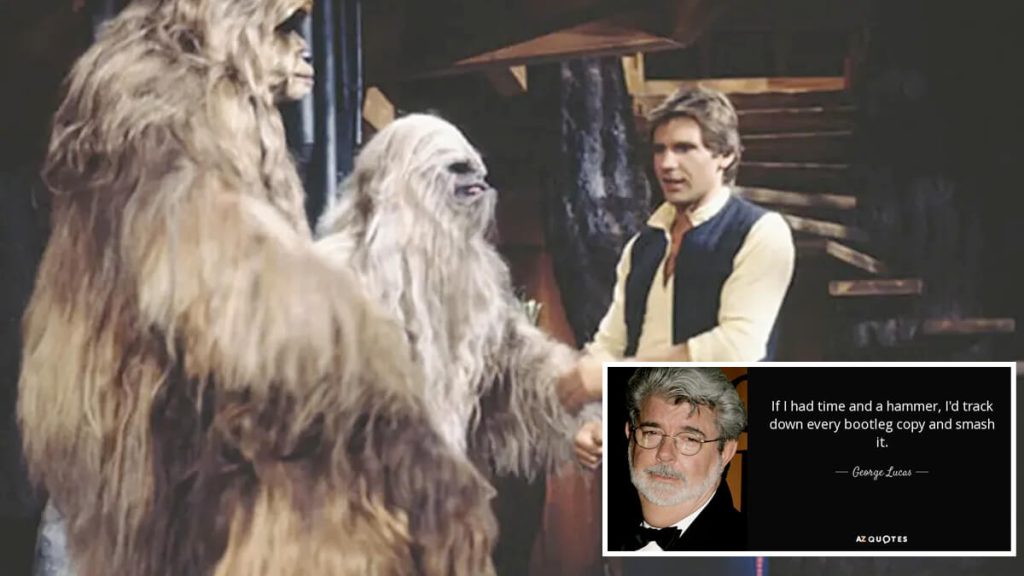
Harrison Ford Comes to Rescue “Indiana Jones”
Anyway … It’s now literally just weeks before production of “Raiders of the Lost Ark” is supposed to begin and Spielberg & Lucas have just learned that that they’ve lost their film’s star. CBS is flat-out refusing to release Tom Selleck early from his “Magnum PI” contractual obligation. So Steven & George now have to find someone else to play Indy … and fast.
The real irony here is … The American Federation of Television and Radio Artists would go on strike in the Summer of 1980 . Which then shut prematurely shut down production of the first season of “Magnum PI.” (As a direct result, the first full season of this action drama to air on CBS only had 18 episodes , rather than the usual 22) . And because this job action lasted ‘til October 23 rd of that same year … Well, this meant that Tom Selleck would have actually been free to start shooting “Raiders of the Lost Ark” on June 23, 1980 because production of Season One of “Magnum PI” was already shut down by then due to that AFTRA strike.
But no one knew – in May of 1980 , anyway – that this job action was going to happen in just a few weeks. All that Steven Spielberg & George Lucas knew was that they now needed a new lead actor for “Raiders.” And circling back on Jeff Bridges was no longer an option. As I mentioned earlier, Jeff had agreed to do “TRON” for Disney. And – in the interim – Bridges gone off to shoot “Cutter’s Way” for MGM / UA.
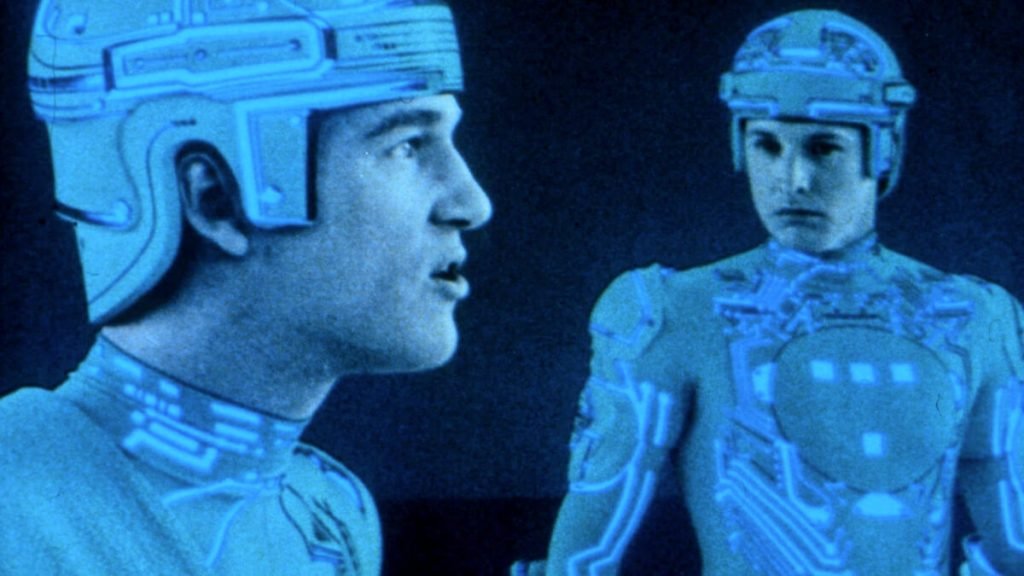
So this is where Harrison Ford enters the equation. As he recalls:
In May of 1980, I get a call from George Lucas. Who says ‘I’m messaging a script over to you this morning. As soon as it gets there, I need you to immediately read this script. Then – as soon as you’re done – I need you to call.
So the script arrives and it’s for ‘Raiders.’ I read it and it’s good. So I call George back and say ‘It’s good.’ And he then says ‘Would you be interested in playing Indy?’ I say that it looks like it would be a fun part to play.
George then says ‘ That’s great to hear. Because we start shooting in four weeks. Now I need you to meet with Steven Spielberg today and convince him that you’re the right guy to play Indy.’
Of course, given that Spielberg had been pushing for Ford to pay Indy ever since he had first seen that work-in-progress version of “The Empire Strikes Back” … Well, Harrison’s meeting with Steven was very, very short. And just a few weeks later, Spielberg, Lucas & Ford were all at the Port de la Pallice in La Rochelle. Where – on the very first day of shooting on “Raiders” (which – again – was June 23, 1980 )– the scene that was shot was the one where that Nazi sub (the one that Indy had lashed himself to its periscope by using his bullwhip as a rope) was arriving at its secret base.
And all of this happened because Harrison immediately agreed to do “Raiders of the Lost Ark” when the part of Indy was first offered to him in mid-May of 1980 .
Before “Star Wars” was “Star Wars”
So why such a quick yes? Well, you have to remember that “Empire Strikes Back” wouldn’t be released to theaters ‘til May 21, 1980 . And no one knew at that time whether this sequel to the original “Star Wars” would do as well at the box office as “A New Hope” had back in 1977 (FYI: “Empire” would eventually sell over $500 million worth of tickets worldwide. Which is roughly two thirds of what the original “Star Wars” earned three years earlier ).
More to the point, the four films that Harrison had shot right after “A New Hope” / prior to “Empire Strikes Back” (i.e., “Heroes” AND “Force 10 from Navarone” AND “Hanover Street” AND “The Frisco Kid”) had all under-performed at the box office. So to Ford’s way of thinking, taking on a role that Tom Selleck was no longer available to play – one that had the potential of spawning two sequels – seemed like a very smart thing to do. Especially after three years of cinematic stumbles.
By the way, whenever this topic ever comes up, Harrison Ford is very gracious. He always makes a point of saying that he’s grateful to have gotten this career opportunity. More to the point, that he still feels kind of bad that Tom Selleck never got the chance to play this part.
Tom Selleck After “Indiana Jones”
That said, we shouldn’t feel too bad for Tom Selleck. After all, the original “Magnum PI” proved to be a long running hit for CBS. And in an effort to smooth over any residual bad feelings that may have resulted from Tom being forced to give up “Raiders” back in May of 1980 , Selleck was eventually allowed to create his own production company (i.e., T.W.S. Productions, Inc. As in Thomas William Selleck Productions). Which – after the fact – was then cut in on some of those “Magnum PI” -related revenue streams.
More to the point, while “Magnum PI” was on hiatus following its second year in production, Selleck flew off to Yugoslavia. Where he then shot his own Indiana Jones-esque film for theatrical release. Which was called “High Road to China” in the States, but – overseas – was promoted as “Raiders of the End of the World.”
FYI: Warner Bros. released “High Road to China” stateside 40 years ago this year . On March 18, 1983 , to be exact. It didn’t do all that great at the box office. $28 million in ticket sales versus $15 million in production costs.
And over the years, there’s even been some talk of finding a way to maybe set things right here. By that I mean: Finally finding a way to officially fold Tom Selleck into the world of Indiana Jones.
Could Tom Selleck Work with Indiana Jones?
The way I hear it, between the time when “Indiana Jones and the Last Crusade” was theatrically released in May of 1989 and when “Indiana Jones and the Kingdom of the Crystal Skull” debuted in May of 2008 , there were a number of ideas for Indiana Jones sequels tossed around. And from what I’ve been told, there was at least one treatment for a fourth Indiana Jones film written that proposed pairing up Harrison Ford & Tom Selleck. With the idea here being that Selleck was supposed to have played Ford’s brother.
Obviously that film was never made. And – no – I don’t know what state Indiana Jones’ brother was supposed to be named after.
This article is based on research for Looking at Lucasfilm “Episode 80”, published on June 29, 2023. Looking at Lucasfilm is part of the Jim Hill Media Podcast Network .
Film & Movies
Will “Metro” – that “Cars” Spin-Off Which Disney Developed – Ever Get Made?
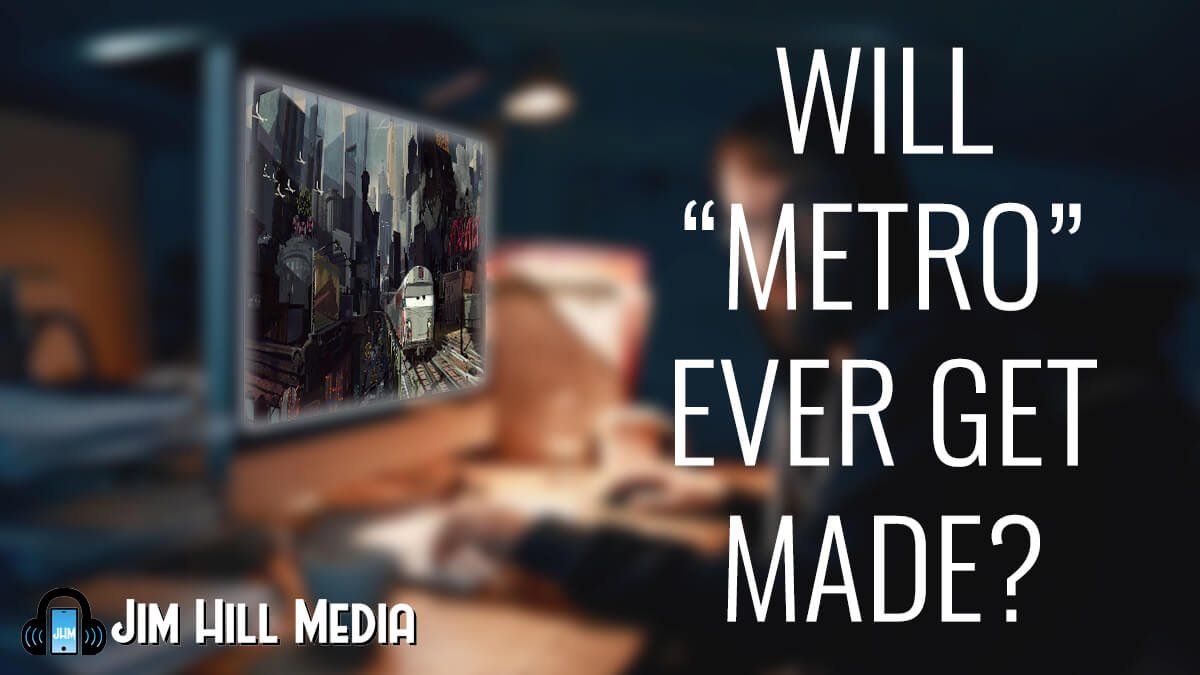
First came “Cars” in June of 2006.
This Pixar Animation Studios production did so well (Of all the high grossing films released that year, “Cars” was No. 2 at the box office. Only “Pirates of the Caribbean: Dead Man’s Chest” sold more tickets in 2006) that Disney execs asked John Lasseter to develop a sequel.
“Cars 2” came out in June of 2011 and also did quite well at the box office (It took the No. 7 slot in the Top-Ten-for-ticket-sales that year). Which is why Disney then asked Pixar to prep a follow-up film.
“Cars 3” would eventually arrive in theaters in June of 2017. But in the meantime, Disney & Pixar began exploring the idea of expanding this film franchise. Largely because the amount of money that the Mouse was making off of the sales of “Cars” -related merchandise was … To be blunt here, mind boggling.
Don’t believe me? Well, then consider this: In just the first five years that the “Cars” film franchise existed, global retail sales of merchandise related to these Pixar movies approached $10 billion. That’s billion with a “B.”
So is it any wonder that – while Pixar was still trying to get a handle on what “Cars 3” would actually be about – the Mouse (through its DisneyToon Studios arm. Which produced home premieres like those “TinkerBell” movies) began actively looking into ways to expand this lucrative franchise?
“Planes” – The First “Cars” Spin-Off
The first “Cars” spin-off to arrive in the marketplace was “Planes.” This Klay Hall film (which was set in “The World Above Cars”) was released theatrically in August of 2013, with the Blu-ray & DVD version of “Planes” hitting store shelves in November of that same year.
“Planes: Fire and Rescue” followed in the Summer of 2014. And while a “Planes 3” was definitely put in development (At the Disney Animation panel at the 2017 D23 Expo, John Lasseter not only shared a clip from this film. But he also revealed that this project – which, at that time, was entitled “Space” – was slated to be released theatrically in April of 2019) … This animated feature was abruptly cancelled when DisneyToon Studios was shuttered in June of 2018.
But wait. There’s more … In addition to the aborted “Planes 3,” Disney had other “Cars” spin-offs in the works. One was supposed to be built around boats. While yet another was supposed to have shined a spotlight on trucks.
“Metro” – The World Below Cars
And then there was “Metro.” Which was supposed to have been set in the inner city and focused on what went on in “The World Below Cars.” As in: Down in the subway system.
Just in the past week or so, a few pieces of concept art for “Metro” have surfaced online. Giving us all an intriguing look at what might have been. These preproduction paintings suggest that this “Cars” spin-off would be far grittier than … Say … the sort of adventures that Lightning McQueen & Mater would typically have out in Radiator Springs.
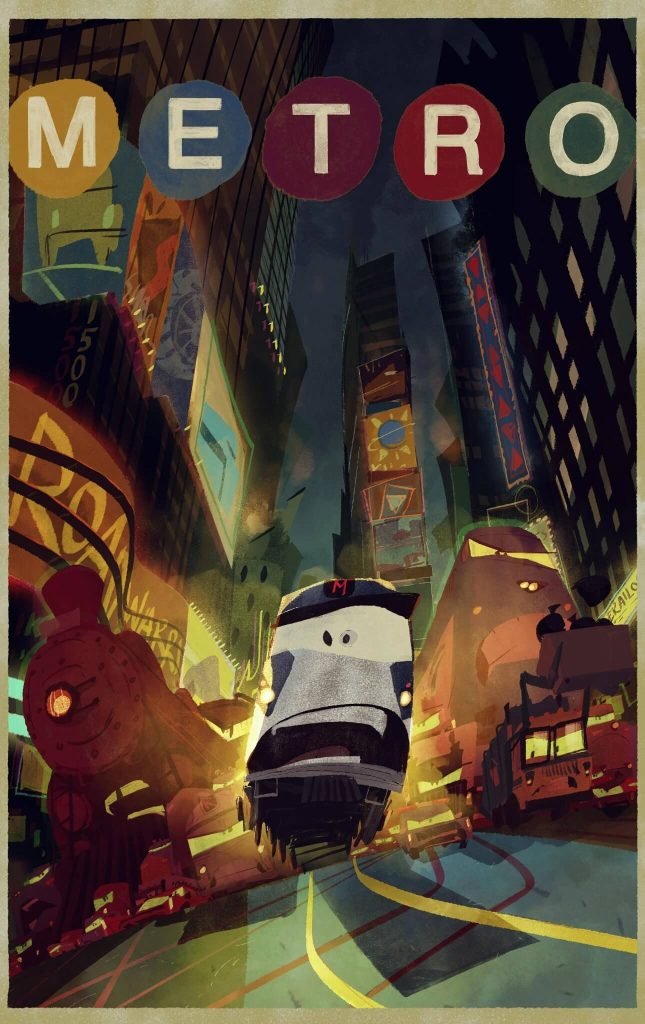
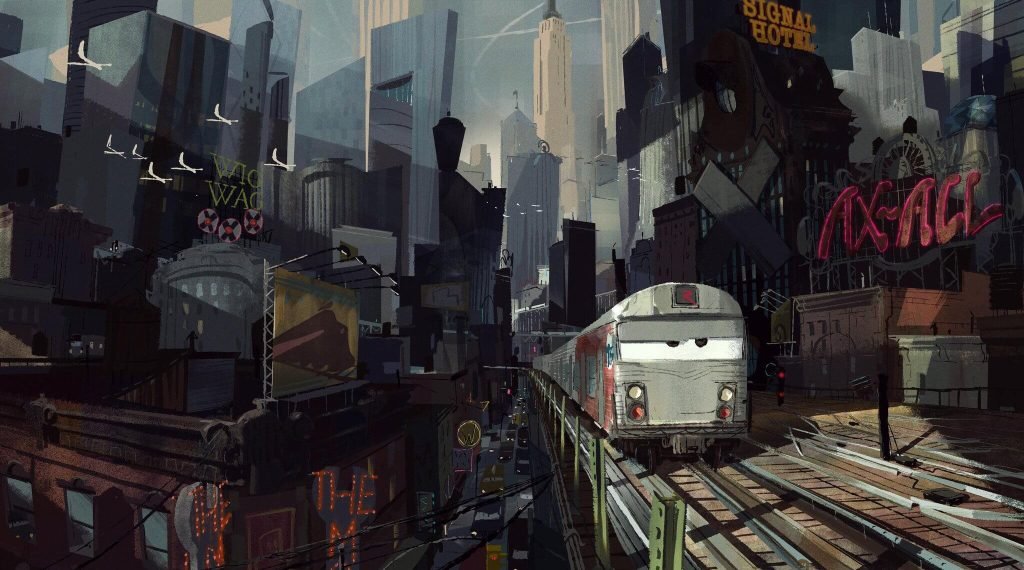
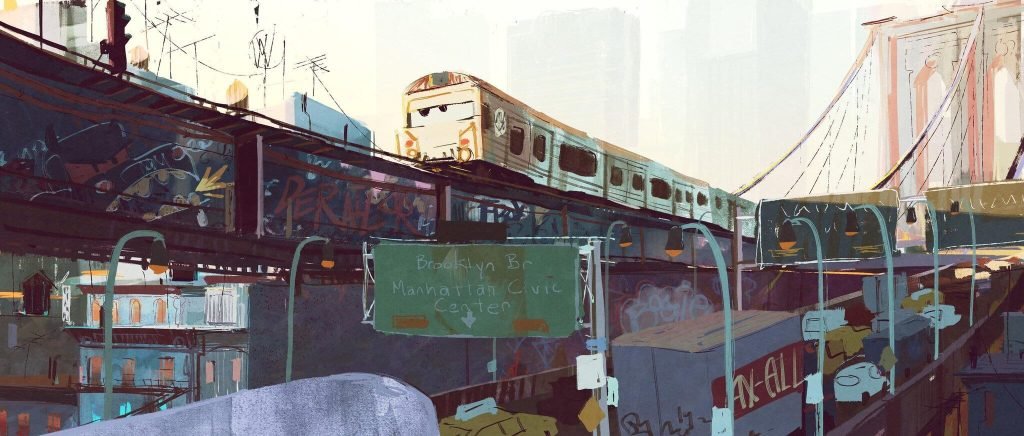
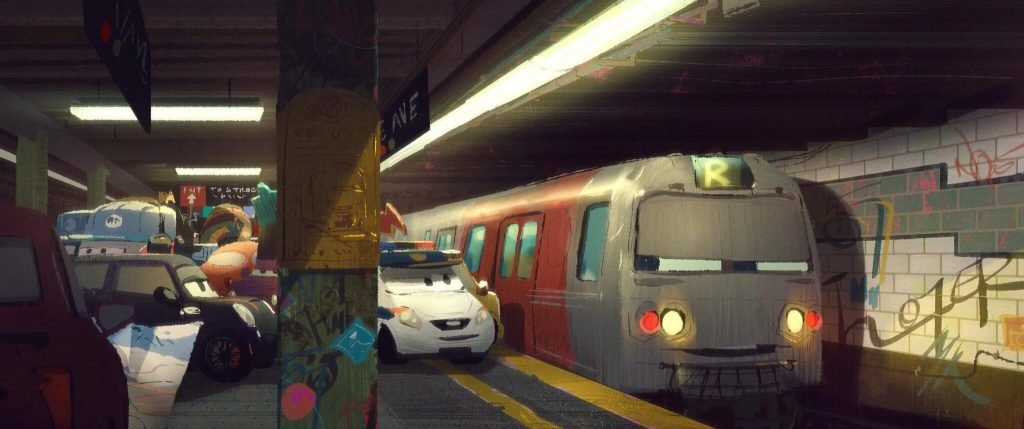
That said, it’s worth noting here that – just in the past year or so – we’ve seen Disney & Pixar attempt to expand the turf that these two characters could comfortably cover. Take – for example — “Cars on the Road,” that nine-part series which debuted on Disney+ back in September of last year. This collection of animated shorts literally sent Lightning McQueen & Mater off on a road trip.
So who knows?
Given that Bob Iger (at Disney’s quarterly earnings call held earlier this week) revealed that the Company now has sequels in the works for “Frozen,” “Toy Story,” and “Zootopia” … Well, is it really all that far-fetched to think that – at some point further on down the road – Disney & Pixar will put yet another sequel to “Cars” in the works?
One that might send Lightning McQueen & Mater off to explore the gritty inner-city world that we glimpsed in all that concept art for “Metro,” that never-produced “Cars” spin-off.
Time will tell.

